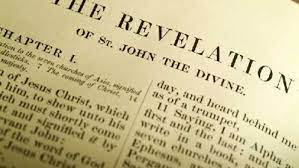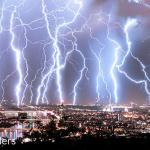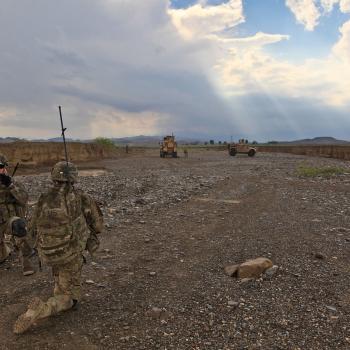 Monday: Read Revelation 1:1-8
Monday: Read Revelation 1:1-8
Revelation 1:1-8 functions as the prologue or the introduction to the book of Revelation. As the prologue, it serves an important role in the book of Revelation in that it sets the context for everything that is to follow.
To begin with, we learn here that the book is “The Revelation of Jesus Christ” (1). This phrase is ambiguous in Greek and English. It likely means that the revelation is both “from” Jesus Christ and “about” Jesus Christ!
In addition, we learn that it is the revelation “which God gave Him” (1). Consequently, it is from God!
One of the difficulties of the book of Revelation is that composed of three genres: apocalypse, prophecy, and epistle.[2] The key is that each of these three genres was concerned primarily with the people to whom they were written. This means that we should not assume that the book of Revelation is about the future. This will be evident as we continue in the book and notice how often John addresses his readers with commands and exhortations to “overcome” or to have wisdom. This means that the book was understandable to its readers. After all, how could they be expected “overcome” if they do not understand what the book is about?
In addition, the book promises a blessing for those who read and do what it says (3). This too affirms that the book must have made sense to those to whom it was addressed.
A key to understanding the book of Revelation is that John believes that Jesus’ life, death, resurrection, and ascension have set in motion what is commonly called the “end-times” or more technically “the eschaton.”[3] This will become especially clear as we read the account of the slain Lamb in Rev 5:1-14.
At this point, I will simply note that the book of Revelation announces that Jesus is Lord and the world’s true King. His death and resurrection have inaugurated what the Bible terms “the last days.” God’s people are to be encouraged and remain faithful. God, after all, is the One who is eternal and, as we will see, He sits enthroned as the world’s true ruler.
For those suffering under the oppressive Roman rule and who are constantly tempted to collude with Rome simply so they may survive, this message was meant to inspire hope and courage to persevere.
Questions to ponder/discuss:
- Compare Rev 1:1 and 22:6.[4] What words or phrases do these two verses have in common? Also, note that 1:1 is the opening verse of the introduction/prologue and 22:6 is the opening verse of the conclusion/epilogue. Thus, these two verses form an “inclusio” or frame around the book of Revelation. This is one of the primary means by which ancient authors will reveal their main purposes or objectives. If so, what then are John’s main goals?
- As we proceed, we will observe many examples of John’s use of numbers.[5] John will often list items in threes (representing God and eternity), four (often representing creation—e.g., “four winds”), and seven (representing perfection). Read the following verses and note the occurrences of three’s:
- 1:3
- 1:4b-5a
- 1:5
- 1:8
- Note the three titles given to Jesus in 1:5 and discuss why you think they might be important for understanding the book of Revelation. Then discuss what you think the significance of these titles is for you and/or the church today.
Tuesday: Read Revelation 1:9-20
Revelation 1:9-3:21 forms the first story or scene in the book of Revelation. This story occurs with John on the island of Patmos (9). He was likely there as some sort of political prisoner. He notes that he was there “because of the word of God and the testimony of Jesus” (9).
John begins by identifying himself as a sharer in the “tribulation”[6] and “kingdom” and “patient endurance” (9).
John then sees the resurrected, glorified Jesus (1:12-20), who commands him to write what he sees and send it to the seven churches: Ephesus, Smyrna, Pergamum, Thyatira, Sardis, Philadelphia, and Laodicea (1:11).
One of the beautiful features of the book of Revelation is that it begins with a magnificent description of the resurrected Jesus! John sees Jesus in all of His glory! John’s description of Jesus includes features that belong to the Father in the OT: such as, “His head and His hair were white like white wool, like snow” (14; see Dan 7:9). Primarily, though, John’s description of Jesus serves to affirm Him as the coming Judge. This was meant to be good news to his readers. After all, it sure seems as if Rome is in power.
The description of Jesus also assures them that Jesus, whom Rome killed, is the “living One” (18) and is alive and well!
Questions to ponder/discuss:
- What do you think is the significance of John’s three-fold description of “tribulation, kingdom, and patient endurance” (9)?
- What message do you think John was trying to tell his readers when He notes that Jesus “was dead, and behold, I am alive forevermore, and I have the keys of death and of Hades” (18)?
- What is the importance of the fact that Jesus is the One who walks among the seven churches: i.e., “lampstands” (20; see 2:1)?
Wednesday: Read Revelation 2:1-7
The seven “messages” in 2:1-3:22 are commonly referred to as the seven letters. Upon closer examination, however, these “messages” do not have much in common with ancient letters. Consequently, they are better titled as “messages.” Each of them is addressed to a church in the ancient province of Asia, which was a Roman area in what is now the western portion of Turkey. The first message is addressed to the Church in Ephesus.
The messages begin with the church in Ephesus—the capital and leading city of the Roman province of Asia. The city was renowned for its massive temple of Artemis (one of the seven wonders of the ancient world).
The church in Ephesus was known for its hard work and especially for testing and discerning of false prophets—who called themselves ‘apostles’ (2, 6).
However, the love in the church had grown cold (4). They are exhorted to rekindle that love (5).
Questions to ponder/discuss:
- It is easy to read the seven messages in isolation from one another. The messages, however, we meant to be read as a whole. Note that each of the messages closes with an exhortation that is addressed to all the churches: “let him hear what the Spirit says to the churches” (7). Also, in the very middle of the fourth and middle of the seven messages, it says, “and all the churches will know that I am He who searches the minds and hearts; and I will give to each one of you according to your deeds” (2:23). This affirms for us that, the messages were meant for them and for all Christians; including us. What then do you think is the significance of this message for you and your church?
- The unique description of Jesus in each of the seven messages is important as it reveals something about Jesus that each particular church needs to understand. After reading the message to the church in Ephesus, what do you think is the significance of the fact that Jesus is the One who walks among the seven lampstands?
Thursday: Read Revelation 2:8-11
Another feature of each of the seven messages is that they include both positive and negative features. That is, each of the churches is praised for the things that are going well and they are exhorted or warned with regard to the things that are not going well. There are some exceptions, however. Notably, the messages to Smyrna and Philadelphia have no negative features.
Those in Smyrna are told that, although they are in “poverty,” the reality is that they are the ones who are “rich” (9).[7] This corresponds with Jesus’ affirmation that the “poor” are the ones who are blessed and the rich are the ones who are cursed (see Luke 6:20, 24).
It appears that those in Smyrna were already suffering “tribulation” (9). In fact, they are told that they were about to face “ten days” of imprisonment (10). The exhortation “Be faithful until death” (10) may even suggest that some of them may face death.
In the message to Smyrna, we are informed that the one who is responsible for their persecution is the devil (10). As we progress through our study of the book of Revelation, we will learn that it is indeed the devil who stands by the opposition to the people of God.
Questions to ponder/discuss:
- After reading the message to the church in Smyrna, what do you think is the significance of the fact that Jesus is the One who is the First and the Last, and who was dead and is alive?
- Each of the seven messages includes a promise “to the one who overcomes.” The church in Smyrna clearly needed to be prepared to “overcome” as suffering was imminent. Read each of the seven exhortations to overcome ((2:7, 11, 17, 26; 3:5, 12, 21) and discern what you believe it means to “overcome.” (Note: we will continue to pursue this question as we read through the book of Revelation).[8]
- I find it interesting that the church in Smyrna was undergoing persecution and suffering and yet nothing negative is reported. Why do you suppose that this was the case?
Friday: Read Revelation 2:12-17
The message to the church in Pergamum (and Thyatira) provides a significant backdrop and as such serves as a major indication of the difficulties the Christians in the first-century Roman world faced.
We know that the Roman imperial cult was thriving throughout the region of seven churches. We also know that these cities regularly (at least once a month) held festivals in honor of the gods. A vital feature of these festivals was the sacrificing of animals to the gods. The sacrifices were then followed by banquets which were hosted by prominent city officials as well as other wealthy individuals in the city.
All of this presented a significant problem for the Christians. Could they engage in the public life of the city and attend the banquets which were in honor of the deities? Of course, not participating had serious consequences both socially and economically.
(Note: it is very difficult for us today, especially in the Western world, to grasp just how problematic this was for the Christians in the Roman world—especially those in the seven churches and the province of Asia).
When some “prophets” came along and told them that it was not a problem for them to attend the banquets and to eat the food that had been offered in religious ceremonies, we might imagine that many welcomed this news. John, however, strongly disagreed.
Questions to ponder/discuss:
- After reading the message to the church in Pergamum, what do you think is the significance of the fact that Jesus is the One with the sharp sword?
- Although it does not appear that the problems facing the church in Pergamum are relevant to us in the West today, there are two things we should note:
- First, there are many brothers and sisters in Christ that are facing such difficulties. As such, it is our duties to assist them with whatever resources we can so that they may be less tempted to compromise their faith. Pray for them and ask for discernment as to whether or not you are called beyond just praying for them.
- Secondly, we must be careful and discerning. Is it possible that our wealth and comfort are the result of compromise?[9]
Our goal is to keep these posts free of charge. I do not intend to ever hide them behind a paywall. I can only do this if those of you who have been blessed by them and can afford to give ($5, $10, $25, or more/month) do so. You can give a tax-deductible contribution by following this link.
Please share this post and let others know about determinetruth.
If you wish to view this blog on your smartphone through the Determinetruth app simply download the “tithe.ly church” app on your smartphone and insert “determinetruth” as the church name you wish to follow. Once it is loaded, simply click on the “blog” icon and it will automatically load.
If you would like to have Rob speak at your church or organization in person or via Zoom, please let us know by filling out the contact info on the Contact me tab on this site.
He is currently completing a commentary on the book of Revelation titled, “Revelation: a Love Story” (Cascade Books, pending 2024).
[1] This guide is meant to be done either as a group study over the course of 2 or 4 meetings (Day 1-5; 6-10; 11-15; 16-20), or as a private devotion over the course of 4 weeks (or a calendar month—5 lessons per week).
[2] See the determinetruth podcast on Mar 20, 27; Apr 3, 2023 (at determinetruth.com: then click on the “podcast” tab”; or search “determinetruth” at Itunes, Spotify, or wherever you get your podcasts) for further discussion of these genres.
[3] See the determinetruth podcast on Apr 17, 2023, for a discussion of “soon” and how John sees Jesus as the fulfillment and the inaugurator of the end-times.
[4] See the determinetruth podcast on Apr 17, 2023, for a discussion of the relationship between 1:1 and 22:6.
[5] Note: John’s use of numbers only enhances the meaning that is already in the text. Numbers are not used to establish meaning or to hide secret codes for us to discern the time of Jesus’ return. For a discussion of John’s use of numbers, see the determinetruth podcast on Apr 24, 2023.
[6] “Tribulation” occurs five times in the book of Revelation (1:9, 2:9, 10, 22: 7:14). For a discussion of “tribulation” in the NT, see my book Understanding the NT and the End Times, 100-118.
[7] The letter Laodicea affirms that material wealth is not a sign of kingdom wealth.
[8] See my book Follow the Lamb, XXX.
[9] I highly recommend Michael Gorman’s work Reading Revelation Responsibly, as well as Scot McKnight and Cody Matchett’s, Revelation for the Rest of Us.













